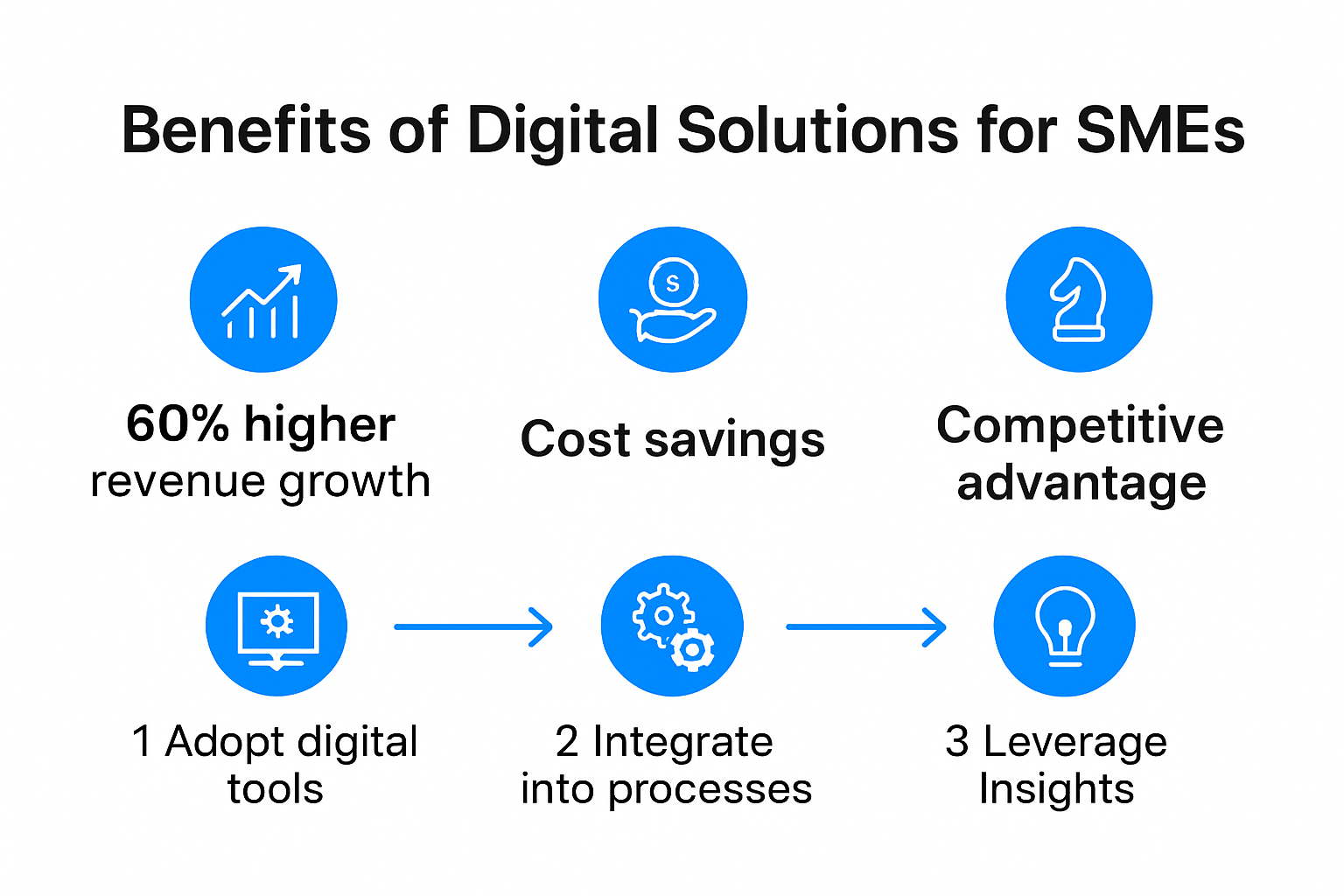Every small business owner knows that digital solutions shape success now more than ever. And yet, a whopping 60 percent of SMEs in South Africa still have not fully embraced digital tools. But what if the real barrier is not about access or cost at all. Turns out, the biggest advantage comes from how you choose and use these technologies rather than which ones you pick.
Table of Contents
- Why Digital Solutions Matter For SMEs
- Best Digital Tools And Platforms In 2025
- How To Choose The Right Solution For Your Business
- Practical Tips For Successful Digital Adoption
Quick Summary
| Takeaway | Explanation |
|---|---|
| Digital Solutions Are Essential for SMEs | Digital tools are crucial for SMEs to thrive in a competitive environment, improving productivity, operational efficiency, and customer experience. |
| Choose Scalable and User-Friendly Tools | When selecting digital solutions, focus on tools that can grow with your business, integrate seamlessly, and are easy for staff to adopt. |
| Develop Digital Literacy | Enhancing digital skills within teams is vital; consider implementing continuous learning programs and engaging with digital experts. |
| Adopt a Strategic Implementation Approach | Use a structured framework for digital adoption to ensure that technology investments align with business objectives and promote ongoing improvement. |
| Manage Financial and Risk Considerations | Start with manageable digital initiatives and explore cost-effective solutions, including government support for SMEs undergoing digital transformation. |
Why Digital Solutions Matter for SMEs
Digital solutions have become the lifeblood of small and medium enterprises (SMEs) in an increasingly competitive business environment. These technological tools are no longer optional extras but critical survival mechanisms that can determine whether a business thrives or merely survives.
The Competitive Edge of Digital Transformation
The digital landscape presents both immense challenges and unprecedented opportunities for SMEs. According to the OECD report on digital transformation, SMEs that effectively leverage digital technologies can dramatically improve their productivity and market reach. Digital solutions enable businesses to streamline operations, reduce costs, and create more personalised customer experiences.
Research published in the journal Sustainability reveals that digital transformation goes far beyond mere technological upgrades. The study emphasises that successful digital adoption requires a comprehensive approach involving strategic planning, organisational changes, and a fundamental reimagining of business processes.

Resilience Through Digital Innovation
In an era of economic uncertainty, digital solutions provide SMEs with critical resilience. A study in the Journal of Management Research highlights how technologies like cloud computing, artificial intelligence, and e-commerce platforms enhance an organisation’s ability to adapt quickly to market disruptions.
Key advantages of digital solutions for SMEs include:
- Operational Efficiency: Automated processes reduce manual work and minimise human error
- Market Expansion: Digital platforms enable businesses to reach customers beyond traditional geographical limitations
- Data-Driven Decision Making: Advanced analytics provide insights that inform strategic planning
- Cost Reduction: Cloud technologies and digital tools can significantly lower infrastructure and operational expenses
For South African SMEs, digital solutions represent more than technological tools they are strategic assets that can level the playing field with larger corporations. By embracing digital transformation, small businesses can create more agile, responsive, and competitive organisations.
The journey towards digital adoption might seem daunting, but the potential rewards far outweigh the initial challenges. SMEs that proactively integrate digital solutions position themselves not just to survive, but to lead in an increasingly digital business ecosystem.
Best Digital Tools and Platforms in 2025
As digital transformation continues to reshape business landscapes, SMEs must strategically select tools that enhance productivity, streamline operations, and drive growth. In 2025, the digital ecosystem offers sophisticated solutions tailored to meet diverse business needs across various sectors.
Productivity and Operational Efficiency Platforms
Modern SMEs require robust digital tools that go beyond basic functionality. According to SCORE’s comprehensive guide, automation and integration platforms have become critical for maintaining competitive edge. Tools like Zapier enable seamless workflow automation, connecting different applications and reducing manual administrative tasks.
Artificial intelligence-driven platforms are revolutionising how businesses operate. AI content creation tools such as Genny provide SMEs with advanced capabilities to generate marketing materials, product descriptions, and communication assets efficiently. These platforms not only save time but also maintain consistent quality across digital communications.
Communication and Collaboration Solutions
Enterprise Nation highlights the critical role of communication tools in modern business ecosystems. Platforms like Slack and WhatsApp Business have transformed team interactions, offering real-time messaging, file sharing, and project management features that transcend traditional communication barriers.
Key digital collaboration tools for SMEs in 2025 include:
- Cloud-Based Project Management: Tools like Asana and Trello enable remote team coordination
- Video Conferencing: Zoom and Microsoft Teams facilitate global communication
- Document Collaboration: Google Workspace allows real-time document editing and sharing

Financial and E-commerce Platforms
Financial management and online selling platforms have become indispensable for SMEs seeking scalable growth. Accounting software like Xero and Sage provide comprehensive financial tracking, invoicing, and reporting capabilities. E-commerce platforms such as Shopify and WooCommerce enable businesses to establish robust online retail presence with minimal technical expertise.
The IMDA’s ‘SMEs Go Digital’ program demonstrates how structured digital adoption can transform small businesses. By providing access to pre-approved digital tools and industry-specific solutions, such initiatives help SMEs navigate the complex digital landscape.
Choosing the right digital tools requires careful consideration of your specific business requirements, budget constraints, and growth objectives. SMEs should prioritise platforms offering scalability, integration capabilities, and user-friendly interfaces. Remember, the most expensive or feature-rich solution is not always the best fit for your unique business needs.
Below is a summary table outlining main types of digital tools highlighted in this section and their key benefits for SMEs:
Here is a quick-reference table summarising the leading categories of digital tools for SMEs in 2025 and their primary benefits:
| Category | Example Platforms | Key Benefits |
|---|---|---|
| Productivity & Efficiency | Zapier, Genny | Workflow automation, content generation, time savings |
| Communication & Collaboration | Slack, WhatsApp Business, Asana, Trello, Zoom, Teams, Google Workspace | Real-time messaging, project management, virtual meetings, document sharing |
| Financial & E-commerce | Xero, Sage, Shopify, WooCommerce | Streamlined finances, online sales, easier expansion |
How to Choose the Right Solution for Your Business
Selecting the most appropriate digital solution represents a critical strategic decision for SMEs. The complexity of modern technological landscapes demands a systematic and thoughtful approach to digital transformation that aligns with specific business objectives and capabilities.
Assessing Organisational Readiness
The OECD report on Digital Transformation of SMEs emphasises that successful digital adoption begins with a comprehensive assessment of current organisational processes and workforce capabilities. Business owners must critically evaluate their existing technological infrastructure, skill sets, and potential gaps before investing in new digital solutions.
Research from the digital transformation study highlights the importance of developing digital awareness and literacy within the organisation. This involves understanding available technologies, their potential impact, and how they can be strategically integrated to enhance business performance.
Strategic Evaluation Criteria
When selecting digital solutions, SMEs should consider multiple critical factors:
- Scalability: Ensure the technology can grow alongside your business
- Integration Capabilities: Choose solutions that seamlessly connect with existing systems
- Cost-effectiveness: Evaluate total ownership costs, including implementation and training
- User Experience: Prioritise tools with intuitive interfaces that require minimal training
The OECD’s policy paper on SMEs Going Digital recommends developing a clear digital strategy aligned with specific business goals. This approach helps mitigate risks associated with random technological investments and ensures that digital solutions directly contribute to organisational objectives.
Below is a process table outlining the recommended steps SMEs should follow when choosing digital solutions, as described in this section:
The following table organises the step-by-step process for selecting the most suitable digital solution for your SME:
| Step | Description |
|---|---|
| Assess Readiness | Evaluate existing processes, technology, and workforce digital skills |
| Identify Business Objectives | Define clear goals for digital investments |
| Set Evaluation Criteria | Consider scalability, integration, cost-effectiveness, user experience |
| Explore Technology Options | Research platforms fitting your objectives and criteria |
| Pilot & Review | Test selected tools, gather team feedback, monitor performance |
| Implement & Train | Roll out solution with adequate staff support and training |
| Monitor & Adapt | Continuously review and refine as business needs evolve |
Implementation and Change Management
Successful digital transformation extends beyond technological selection. Businesses must invest in comprehensive change management strategies that address potential workforce resistance and facilitate smooth technological adoption. This involves:
- Providing adequate training and support
- Creating a culture of continuous learning
- Establishing clear communication channels
- Monitoring and evaluating digital solution performance
Remember that digital solutions are not one-size-fits-all. Each business requires a unique approach tailored to its specific operational context, industry dynamics, and strategic vision. Regularly reassess your digital strategy, remain adaptable, and be prepared to pivot as technological landscapes evolve.
By adopting a strategic, informed approach to digital solution selection, SMEs can transform technological investments from potential risks into powerful drivers of business growth and innovation.
Practical Tips for Successful Digital Adoption
Digital adoption represents a transformative journey for SMEs, requiring strategic planning, commitment, and a holistic approach to technological integration. While the process might seem complex, businesses can navigate digital transformation effectively by implementing targeted strategies and maintaining a flexible mindset.
Developing Digital Literacy and Skills
The OECD report on Digital Transformation of SMEs emphasises the critical importance of building digital skills within organisations. This goes beyond mere technical training and encompasses developing a comprehensive understanding of how digital technologies can drive business innovation and growth.
Key strategies for enhancing digital literacy include:
- Continuous Learning Programs: Implement regular training workshops and online courses
- External Skill Acquisition: Consider hiring digital specialists or consultants
- Peer Learning Networks: Engage with industry groups and digital transformation communities
Strategic Implementation Approach
The OECD’s ‘SMEs Going Digital’ policy paper recommends a structured approach to digital adoption. This involves developing a clear digital strategy that aligns technological investments with specific business objectives.
The DASAT framework from digital transformation research provides a systematic guide for SMEs, encompassing:
- Digital Awareness: Understanding available technologies and their potential impact
- Strategy Development: Creating a comprehensive digital transformation roadmap
- Adoption: Implementing selected digital solutions strategically
- Continuous Improvement: Regular evaluation and iterative enhancement of digital capabilities
Risk Management and Financial Considerations
Successful digital adoption requires careful financial planning and risk mitigation. SMEs should:
- Start with small, manageable digital initiatives
- Prioritise solutions offering clear return on investment
- Explore government grants and support programs for digital transformation
- Maintain flexibility to pivot and adjust strategies
Financial constraints should not deter digital transformation. Many cloud-based and software-as-a-service solutions offer scalable pricing models that accommodate businesses of different sizes and budgets.
Remember that digital adoption is not a destination but a continuous journey of innovation and adaptation. Businesses that approach digital transformation with patience, strategic thinking, and a willingness to learn will be best positioned to leverage technological advancements effectively.
By embracing a proactive and structured approach, SMEs can transform potential technological challenges into opportunities for growth, efficiency, and competitive advantage.
Frequently Asked Questions
What are the essential digital solutions for SMEs in 2025?
Digital solutions for SMEs in 2025 include productivity and operational efficiency platforms, communication and collaboration tools, and financial and e-commerce platforms. These technologies help streamline operations, enhance team communication, and manage finances effectively.
How can SMEs choose the right digital tools for their business?
SMEs should assess their organisational readiness, identify their business objectives, and evaluate potential solutions based on scalability, integration capabilities, cost-effectiveness, and user experience. A clear digital strategy aligned with specific goals is crucial.
Why is digital transformation important for small businesses?
Digital transformation is crucial for SMEs as it improves productivity, operational efficiency, and customer experience. It enables businesses to adapt quickly to market changes, leverage data analytics for informed decision-making, and compete effectively in the marketplace.
What practical tips can help SMEs successfully adopt digital solutions?
To successfully adopt digital solutions, SMEs should focus on developing digital literacy among employees, implementing a strategic approach to technology integration, and managing financial risks by starting with small initiatives. Engaging in continuous learning and adapting strategies as needed is also essential.
Take Control of Digital Growth for Your SME in 2025
Are you frustrated by outdated technology or the slow pace of digital change in your business? The article makes it clear: embracing digital solutions is the turning point for South African SMEs wanting real growth and resilience. If your team struggles with disjointed processes or you worry your online presence is not doing your brand justice, you are not alone. Modern web design, streamlined business apps, and secure cloud services are the backbone of success for companies set on thriving in a digital-first world.
You do not have to tackle these challenges alone. Cloud Fusion specialises in bespoke solutions designed specifically for businesses like yours. Whether you need a responsive website that builds trust, custom business software to boost efficiency, or seamless digital integration, our team delivers every step of the way. See what is possible with a free web design and development quotation or dive into our full suite of industry-leading cloud and productivity tools to match your business ambitions. Make your move today and let Cloud Fusion open the doors to your SME’s digital future at https://www.cloudfusion.co.za/solution/web-design-and-development-quotation.








